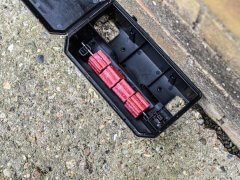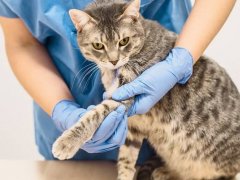
- Background
- As Soon as Your Cat Is Hit: What To Do First
- Safely Check To See if the Cat Is Alive
- Safely Transporting the Cat to the Vet
- Helping a Cat in Shock
- What Happens at the Vet
- Diagnosis & Treatment Options
- Types of Injuries and Complications Your Cat Might Have
- Will My Cat Survive?
- How To Prevent a Cat From Being Hit by a Car
- Frequently Asked Questions
If your cat spends any time outside, the biggest risk to their health is the motor car. Road accidents are one of the most common reasons cats need to be taken to the vet urgently. Vets have special abbreviations which they commonly use: HBC means “hit by car”, while RTA means “road traffic accident.”
If your cat is hit by a car, you need to know what to do in a hurry. This article aims to give you a clear, step-by-step, guide to help you quickly and easily if this happens.
Background
It’s common for cats that go outside to be hit by a car. Some important facts to know about this problem include:
- Road accidents make up around 4% (one in 25) of the cases taken to veterinary emergency clinics.
- Cats aged 6 months to 2 years are at increased risk of road traffic accidents
- Male cats are more at risk than female cats
- Road accidents have a seasonal peak, in the autumn
- If a cat suffers spinal or abdominal injuries, there’s a higher risk of fatality
- Cats are sometimes hit when fleeing from predators, as they are more concerned with escaping than watching traffic carefully
The first 24 hours after an accident are critically important, so it’s essential that you take your cat to the vet as rapidly as possible for a full and detailed assessment.
As Soon as Your Cat Is Hit: What To Do First
If you see a cat being hit by a car, you need to act at once, but you also need to look after your own safety. Roads are dangerous places—remember that while you are very focused on helping the cat. Nobody else may be aware that a cat has been hit, and cars will continue on the road at speed, very close to you. This is a difficult time, as your emotions will be on high alert after the shock of witnessing the accident.
First, get the cat off the road, so that both the animal and yourself are out of the way of oncoming traffic. An injured cat might be defensively aggressive, and might try to run away (if it can). You might wish to use a fabric item such as a jacket, towel, or blanket to wrap gently around the cat so you can restrain them safely while you move them to a safe, flat surface where you can assess them more closely.
If the cat is not yours, consider contacting your local animal shelter or animal control to report the accident.
Safely Check To See if the Cat Is Alive
At the roadside, once you have the cat safely out of the roadway, check is to make sure the cat is still alive. Obvious signs of life include:
- Movement
- Breathing
- Blinking
If the cat is not moving at all, if there is no breathing, and if the eyes are open, with no blinking, then sadly, the cat has died, and there is nothing more you can do.
Safely Transporting the Cat to the Vet
If the cat is still alive, get them to the nearest veterinary clinic as rapidly as possible.
First, make sure that you have them securely restrained. Cats that are injured might try to run away in panic. After your initial restraining method (e.g. jacket, towel, blanket), try to transfer the cat into a more secure place. Ideally, a cat carrier is safest, but other options include a cardboard box, or even sitting inside a car, holding the cat, restrained, on your lap.
Make a phone call to the vet at once, so that they are expecting you to arrive. This advance notice will give them time to make preparations to take immediate action as soon as you arrive at the clinic.
Helping a Cat in Shock

Before deciding what to do next, check the cat to look for signs of life.
Immediately after a cat is hit by a car, they often go into shock. This is a temporary state that the body enters as a type of immediate protection after physical trauma, with low blood pressure and other internal changes to the metabolism.
Visible symptoms of shock include:
- Either excitement or depression—not “normal” behavior or reaction to their surroundings
- Rapid heart rate
- Gums might be pale
- The cat might feel cold to touch
- Breathing altered—might be slow or rapid, and shallow or deep, but not “normal”
- Eyes may appear glazed and unfocussed
A cat in shock needs to be treated by a vet, with intravenous fluids, pain relief, and other medication. In the very short term, as you travel to the vet, there is little you can do other than:
- Stop any bleeding from lacerations with direct pressure to the damaged blood vessels. If a limb is bleeding you may use a clean sock as a substitute for a bandage, placing it over the limb and holding it gently in place.
- Make sure the cat has no obstruction to their breathing (for instance, blood clots around nose).
- Keep the cat warm, wrap them inside a blanket and make sure the car is warm inside.
What Happens at the Vet
When you arrive at the vet, it’s likely that the cat may be immediately taken away from you so emergency treatment can start at once. However, you will have to stay and spend some time talking to one of the vets to give details of what has happened.
Diagnosis & Treatment Options
If a road accident is not directly witnessed, clues include oil on the coat, tire imprints on the body, and scuffed claws (cats dig their nails into the road at the moment of impact with the car, leading to scuffed, shredded nail tips).
Veterinary treatment depends on the injuries suffered by the cat, with a huge range of possibilities. The priority is to stabilize the cat first (e.g., treating shock with intravenous fluids) and then to give appropriate treatment as needed. General treatment often includes anti-inflammatory pain relief to reduce discomfort and to lessen inflammation and swelling of damaged tissues. Antibiotics might be prescribed to prevent infections with bacteria of contaminated open wounds.
With that said, the following steps are usually taken to help your cat.
1. Detailed History Taking
If the cat is yours, your vet will ask about aspects of your cat’s situation, including their day-to-day routine, diet (when did the cat last eat?), and any previous medical issues. You will be asked about any details of the accident you might have witnessed, including when, precisely, it happened. Did you observe precisely what happened? Did the car wheel go over the cat (increasing the risk of damage to internal organs)? Did the cat run afterward or just lay still? Was there any bleeding at the time?
Veterinary care costs after a road accident can be high. If the cat is yours, you might also be asked to give details of your pet insurance if you have this in place. You may also wish to ask for an initial estimate of expected costs.
The rest of the activities at the vet will probably take place behind closed doors, in the treatment area. You might be asked to wait to hear about the initial assessment, or you may be asked to leave, with full details being passed onto you later by phone.
2. Physical Examination
Your veterinarian will immediately examine the cat’s body carefully, checking the breathing, the pulse and mucous membranes, feeling the cat all over, checking for any abnormalities. An intravenous line might be set up at once, giving emergency treatment for shock. Oxygen supplementation may be offered, and any other urgent medical issues may be tackled (e.g., stopping bleeding, giving pain relief).
A full physical examination, including taking the cat’s temperature, listening to their lungs and heartbeat with a stethoscope, and weighing them, will happen around the same time.
3. Routine Blood and Urine Tests
In the immediate aftermath of the accident, your veterinarian may carry out blood work, including the usual panel of diagnostic tests, such as hematology (complete blood count, or CBC) and biochemistry profiles. Simple urine tests may also be carried out.
This type of workup is known as the minimum database, and it’s carried out to review most cats in need of veterinary help, regardless of the signs of illness. The results will provide helpful guidance about the cat’s overall state of health as well as the injuries they have sustained in the accident.
4. Diagnostic Imaging
Radiography (x-rays) and ultrasound examinations (scans) may be carried out to assess injuries. Depending on the case, more detailed diagnostic imaging (such as CT or MRI scan) might be recommended.
5. Referral to a Specialist
Your local veterinarian might recommend referral to a veterinary specialist if your cat has suffered certain severe injuries (some types of fractured bones, ruptured diaphragm, and others).
6. Initial Treatment of Injuries

Treatment for a cat that has been hit by a car varies depending on the injuries sustained.
Veterinary treatment depends on the injuries suffered by the cat. The priority is to stabilize the cat first, and then to give appropriate treatment as needed. General treatment often includes anti-inflammatory pain relief to reduce discomfort and to lessen inflammation and swelling of damaged tissues. Antibiotics might be prescribed to prevent infections with bacteria of contaminated open wounds.
Types of Injuries and Complications Your Cat Might Have
There is a long list of possible consequences that can follow a road traffic accident, but some of the more common serious issues include:
Long Bone Fractures
The long bones are the humerus, radius, and ulna in the fore legs, and the femur, tibia, and fibula in the hind legs. These bones are common fractured during road accidents and generally need complex surgical orthopedic repair.
Pelvic Fractures
Pelvic fractures are common in cats that have been hit by a car, especially if the wheel ran over their rear end. There are many different types of pelvic fracture, and the best way forward is a detailed assessment after x-rays have been taken to clearly demonstrate the pattern of fractures.
Jaw Fractures
If the cat’s head is involved in the collision, head injuries including fractured jaws are common. Again, there are many different types of fracture, from the simplest (separation of the mandibular symphysis, which can usually be easily repaired) to the most complex (multiple fractures of other parts of the jaw).
Again, x-rays and an examination under anesthesia should clarify the extent of the fractures, and the action that needs to be taken. If the head was struck by the car, there may be a risk of concussion and seizures.
Diaphragmatic Rupture
When the cat’s body has been run over by a car, there is a risk of a diaphragmatic rupture, when there is a tear in the diaphragm (the sheet of thin muscle separating the abdomen from the chest), allowing abdominal contents (liver, stomach, or intestines) to enter the chest.
This is diagnosed or ruled out by taking x-rays. A ruptured diaphragm requires complex, specialized and expensive surgical repair, but it’s important to stabalize the cat first, before this is carried out. There are often chest injuries as well, such as broken ribs.
Bladder Rupture
When the abdomen has been exposed to physical trauma, if the cat’s bladder was full at the time, there is a risk that the bladder may rupture, releasing urine into the abdomen. This requires urgent surgical repair.
Diagnosis may be made from x-rays or ultrasounds, and this may not be immediately obvious. Careful monitoring of the cat’s urination pattern after an accident is an important part of the immediate care of a cat after a road accident. If they are not passing urine, then it’s especially important to double-check for a ruptured bladder.
Tail Pull Injury
When the tail is forcibly pulled away from the body, this is known as a “tail pull injury.” As well as the trauma to the tail (sometimes including a degloving injury, where the skin of the tail is removed, leaving just a bloody surface), there’s often damage to the nerves around the lower spine, resulting in interference with the cat’s ability to pass urine and feces.
These are essential life functions, and sadly, some cats with tail pull injuries eventually need to be euthanized because of an inability to urinate and defecate. X-rays of the pelvis and tail area will usually demonstrate if there is a tail pull injury, but a neurological examination of the cat, as well as observation of their ability to use the litter box, is also important.
Will My Cat Survive?

A cat’s prognosis depends on many factors, including what injuries occurred and the severity of those injuries.
It’s difficult to predict whether or not a cat will survive being hit by a car. There are so many different factors and possible complications involved. The prognosis depends on which body parts were damaged, and the severity of that damage.
Patience is needed while a full assessment is carried out. After 24 to 48 hours, it’s usually possible for your veterinarian to give you an estimate of the prognosis.
How To Prevent a Cat From Being Hit by a Car
The ultimate way to prevent road accidents is keeping your cat indoors at all times. If you cat does go outside, you might wish to invest in special cat proof fencing to keep them contained in your backyard or garden.
If you cannot do this, it can help if they wear a reflective collar so that they are seen more easily in car headlights. Neutering male cats helps to prevent them wandering so far from home, and this reduces the risk of being hit by a car. Sometimes cats are run over on their own driveways by their owners. Be sure to check under your car before driving off, especially if you have an older cat that might be less mobile.
Also Read: 11 Signs That You Need to Get Your Cat To the Emergency Room
Frequently Asked Questions
What happens if a cat gets hit by a car?
If a cat is hit by a car, there are likely to be significant injuries, and the consequences can vary from immediate death to severe injuries to just minor trauma. Often injuries might not be immediately apparent, so it is important that your cat is carefully examined by your veterinarian as soon as possible.
How do you help a cat that has been hit by a car?
If you do not witness the accident, it can be impossible to be sure that a cat has been hit by a car. If a cat has significant injuries, this is always a likely possibility. Clues that this may have happened include oil on the coat, tire imprints on the body, and scuffed claws (a cat digs their nails into the road at the moment of impact with the car, leading to scuffed, shredded nail tips). The best way to help is to get them to the vet as soon as possible.
How do you know if your cat has internal bleeding?
The risk of internal bleeding is one of the reasons why an examination by a veterinarian is so important. The signs can be invisible to a lay person, but they can include a swollen abdomen, pale gums, and difficulty breathing (labored, fast, or panting).
Is it common for cats to get hit by cars?
Around 4% of the feline cases that attend veterinary emergency clinics have been hit by cars. All cats that spend time outdoors are at risk of being hit by a car. Male cats are more likely to be hit than female cats, and the fall is the most likely time of year for cats to be hit by cars.







